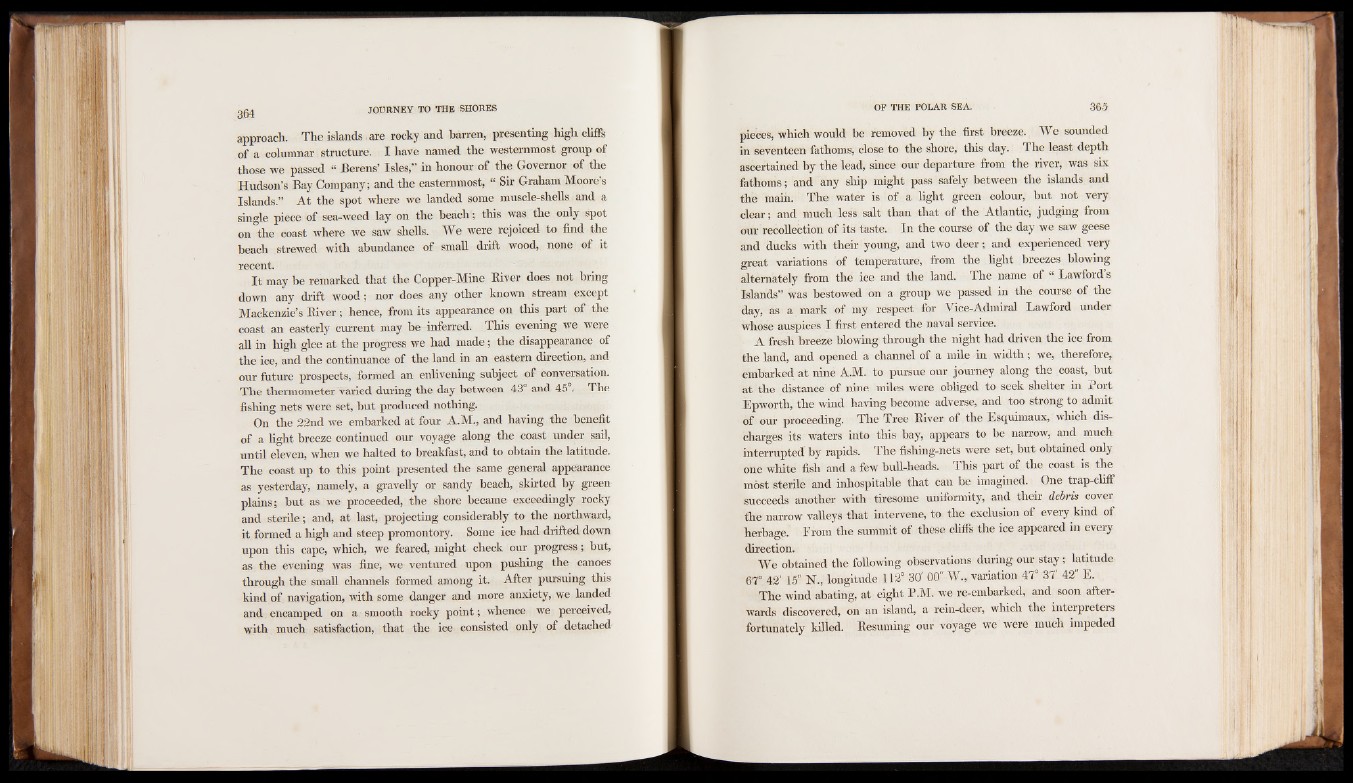
approach. The islands are rocky and barren, presenting high cliffs
of a columnar structure. I have named the westernmost group of
those we passed “ Berens’ Isles,” in honour of the Governor of the
Hudson’s Bay Company; and the easternmost, “ Sir Graham Moore’s
Islands.” At the spot where we landed some muscle-shells and a
single piece of sea.-weed lay on the beach; this was the only spot
on the coast where we saw shells. We were rejoiced to find the
beach strewed with abundance of small drift wood, none of it
recent.
It may be remarked that the Copper-Mine Biver does not bring
down any drift wood; nor does any other known stream except
Mackenzie’s Biver; hence, from its appearance on this part of the
coast an easterly current may be inferred. This evening we were
all in high glee at the progress we had made; the disappearance of
the ice, and the continuance of the land in an eastern direction, and
our future prospects, formed an enlivening subject of conversation.
The thermometer varied during the day between 43° and 45 . The
fishing nets were set, hut produced nothing.
On the 22nd we embarked at four A.M., and having the benefit
of a light breeze continued our voyage along the coast under sail,
until eleven, when we halted to breakfast, and to obtain the latitude.
The coast up to this point presented the same general appearance
as yesterday, namely, a gravelly or sandy beach, skirted by green
plains; but as we proceeded, the shore became exceedingly rocky
and sterile; and, at last, projecting considerably to the northward,
it formed a high and steep promontory. Some ice had drifted down
upon this cape, which, we feared, might check our progress; but,
as the evening was fine, we ventured upon pushing the canoes
through the small channels formed among it. After pursuing this
kind of navigation, with some danger and more anxiety, we landed
and encamped on a smooth rocky point; whence we perceived,
with much satisfaction, that the ice consisted only of detached
pieces, which would be removed by the first breeze. We sounded
in seventeen fathoms, close to the shore, this day. The least depth
ascertained by the lead, since our departure from the river, was six
fathoms; and any ship might pass safely between the islands and
the main. The water is of a light green colour, but not very
clear; and much less salt than that of the Atlantic, judging from
our recollection of its taste. In the course of the day we saw geese
and ducks with their young, and two deer; and experienced very
great variations of temperature, from the light breezes blowing
alternately from the ice and the land. The name of “ Lawford s
Islands” was bestowed on a group we passed in the course of the
day, as a mark of my respect for Vice-Admiral Lawford under
whose auspices I first entered the naval service.
A fresh breeze blowing through the night had driven the ice from
the land, and opened a channel of a mile in width; we, therefore,
embarked at nine A.M. to pursue our journey along the coast, but
at the distance of nine miles were obliged to seek shelter in Port
Epworth, the wind having become adverse, and too strong to admit
of our proceeding. The Tree Biver of the Esquimaux, which discharges
its waters into this bay, appears to be narrow, and much
interrupted by rapids. The fishing-nets were set, but obtained only
one white fish and a few bull-heads. This part of the coast is the
móst sterile and inhospitable that can be imagined. One trap-cliff
succeeds another with tiresome uniformity, and their debris cover
the narrow valleys that intervene, to the exclusion of every kind of
herbage. From the summit of these cliffs the ice appeared in every
dirWectei oonb.tained the following observations during our stay ; latitude
67° 42' 15" N., longitude 112° 30' 00" W., variation 47° 37' 42" E.
The wind abating, at eight P.M. we re-embarked, and soon afterwards
discovered, on an island, a rein-deer, which the interpreters
fortunately killed. Besuming our voyage we were much impeded